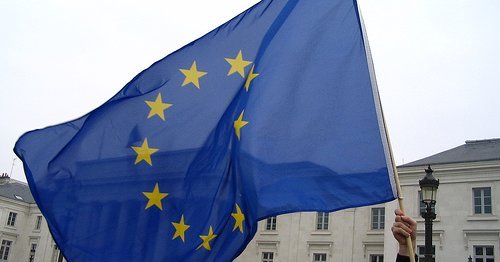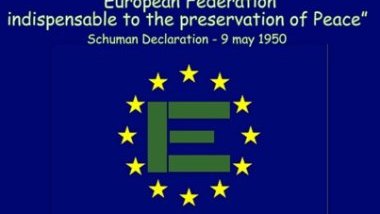This is explicitly stated in the declaration, which establishes the pooling of coal and steel production, managed by an authority independent from national governments and whose decisions are binding on France, Germany and the other subscribing countries. It represents “a first concrete foundation of a European federation”, which provides a key contribution to the creation of world peace. Precisely because the final goal has not been achieved yet, the declaration is still of topical interest, not only in relation to the rules and purposes it sets but also due to the crucial choice of making a qualitative leap forward without being hindered by national vetoes. That being stated, I shall focus on the analysis of three main points: 1) the genesis of the Schuman Declaration; 2) its federalist content; 3) its topicality.
Precisely because the final goal has not been achieved yet, the declaration is still of topical interest, not only in relation to the rules and purposes it sets but also due to the crucial choice of making a qualitative leap forward without being hindered by national vetoes.
1. The genesis of the Schuman Declaration
The dynamics of the European unification process were illuminatingly clarified by Altiero Spinelli, in an embryonic way in the Ventotene Manifesto (written in 1941 and representing the founding document of the movements fighting for the federal unification of Europe) and then, more precisely, after the War. According to the founder of the [?European Federalist Movement], the European unification process is based on a deeply rooted and enduringly powerful historical drive, deriving from the structural and irreversible crisis of the European national States. This basically consists in the structural inability to face, by means of absolute national sovereignty, the fundamental problems of economic development, democratic progress and security, which have become supranational issues due to the growing and unrelenting interdependence created by the advancement of the industrial revolution. After the collapse of the European system of States occurred at the end of the World Wars period (during which the hegemonic unification of Europe had been attempted), national democratic governments were faced with the unavoidable choice between “joining or dying”, a situation that the French Minister of Foreign Affairs Aristide Briand had already foreseen in September 1929, when he presented the first proposal for a united Europe put forward by a national government. This led to the establishment of a European unification policy having a sound structural basis but hindered by a major structural obstacle, i.e. the tendency by those who hold national power – deriving from the law of self-preservation of power already explained by Machiavelli – to oppose the actual handing over of most of that power to federal supranational institutions, a prerequisite without which an effective, democratic and irreversible unification of Europe cannot be achieved.
A strong European unification policy can assert itself only when the structural crisis of the national States results in a severe crisis of power as well as in complete government impasse...
Given this contradictory stance held by the national governments, a strong European unification policy (going beyond mere intergovernmental cooperation based on unanimous resolutions) can assert itself only when the structural crisis of the national States results in a severe crisis of power as well as in complete government impasse. The process also requires the presence of bold statesmen and the active participation of authoritative personalities – yet independent from the logic of conquering and preserving national power – and movements working towards the federal unification of Europe and the mobilisation of the general public in support of this objective.
It was such a situation that inspired Schuman’s action in 1950. Until then, policies for the unification of Europe had been pursued in Western Europe (the only portion of the continent in which there was a certain freedom of choice). These policies had been stimulated by the failing power of national States, the breaking out of the Cold War, and the decision by the U.S., with the Marshall Plan established on 5th June 1947, to link recovery aid to the establishment of intra-European cooperation. However, the international organisations that were created as a direct or indirect consequence of pressures by the U.S. – i.e. the Organisation for European Economic Cooperation (which in 1960 became the Organisation for Economic Cooperation and Development), the Brussels Pact (which in 1955 became the Western European Union), and the Council of Europe– were characterised by an extremely weak confederal structure. This was mostly due to the fact that the United Kingdom (a country in which the historical crisis of the national State had manifested itself less evidently), the main founding country of said organisations together with France, was particularly strict in defending national sovereignty and the other partners were unwilling to proceed without the United Kingdom. The qualitative leap from these early, weak forms of European cooperation to a European integration process was strongly facilitated by the evolution of the German question, induced by the American policy.
A fundamental corollary of the American strategy for the containment of the Soviet block (which, starting from the Truman Doctrine of 12th March 1947, had led to the Marshall Plan and then to the establishment of the Atlantic Alliance) was the decision to carry out the economic and political reconstruction of the portion of Germany occupied by the Western powers, rejecting the previous policy which had aimed at preserving the division among Western occupation areas and at severely limiting the economic development of Germany. Aware of the fact that, without the full recovery of one of the nations that had always been crucial for the economic development of Europe, Western Europe would have remained fatally weak, the Americans achieved the creation of the Federal Republic of Germany and then included in their agenda the elimination of any obstacle to the full development of the German economy. As a consequence, they enabled the Germans to reclaim their heavy industry, which was under the Ruhr International Authority and hence subject to production limitations. Faced with this decision by the U.S., the French government – whose foreign minister was now Robert Schuman, representative of the “party for the reconciliation with Germany” – was caught between two fires: severe concerns about the future revival of the German power, based on its economic recovery, and the prospect of a heavy diplomatic clash, doomed to failure, with the Americans, determined to accomplish the full economic recovery of West Germany without delay. Nevertheless, France was able to overcome this impasse with the courageous proposal, put forward by Jean Monnet, to place under common European control the coal and steel industry of Germany, France and any other European country willing to undertake this venture. Following immediate positive responses by Adenauer in Germany (Adenauer was the leader of the German party for the reconciliation with France), De Gasperi in Italy, and the Benelux countries, the problem was solved by creating, as suggested by the Schuman Plan, an organisation that was completely new if compared to the Brussels Pact, the OEEC, and the Council of Europe.
What is fundamentally new about the European Community of Coal and Steel is the federal perspective it implies. Before proceeding with a detailed analysis of this aspect, I wish to clarify two issues. First of all, the extremely important link between the German question and European integration does not at all mean that integration is a tool to exert control over Germany. The European unification actually originates in the permanent and irreversible crisis of the system of European national States, which during the period of the World Wars and the antifascist Resistance led to a widespread awareness of the “joining or dying” issue. Against this background, without which the European unification process could not have started and developed, the issue of Germany (the last State in modern history aiming at hegemony over Europe, after Spain and France) peacefully living together with the other European countries has played a crucial role, since it has provided the most progressive pro-Europeans – in France, Germany, and other partner countries – with a significant and concrete political resource to overcome any nationalistic oppositions to a deep supranational unification policy.
Secondly, it should be underlined that one of the fundamental reasons for Schuman’s ability to overcome nationalistic opposition in his country lay in the method he adopted to develop his action. He prepared the launch of the ECSC project without involving the personnel of the Ministry for Foreign Affairs, knowing full well that there would have been strong opposition capable of thwarting his initiative right from the start. He instead entrusted Monnet and his collaborators from the Planning Commission with the drafting of the Plan and worked towards raising public support in France and in the other countries, in order to make it harder for the diplomacy or the entrepreneurial world to run the project aground.
2. The federalist content of the Schuman Declaration
If by federation we mean the overcoming of absolute national sovereignty through the creation of a federal State (a State of States) and thus of supranational democratic institutions with direct power over the citizens of the federation and with direct participation by the national States in the decision-making process, hence ensuring the preservation of their inviolable autonomy, then it is evident that Schuman’s initiative contains a federal perspective. Despite not having led to the establishment of a fully-fledged federation, it achieved the overcoming of simple intergovernmental cooperation and it laid the foundations for the creation of a federal State, since only the brave and dramatic decision of relinquishing exclusive national sovereignty was capable of preventing a prospect, i.e. the full re-establishment of German sovereignty, that was rightly perceived as full of extremely dangerous implications.
It is evident that Schuman’s initiative contains a federal perspective. Despite not having led to the establishment of a fully-fledged federation, it achieved the overcoming of simple intergovernmental cooperation and it laid the foundations for the creation of a federal State.
More precisely, if we wish to wholly understand the federalist content of Schuman’s proposal, we should refer above all to Monnet’s vision, as he was the main inspirer of the proposal. The functionalist approach to European integration, which Monnet consistently and practically supported, and the federalist approach, which undoubtedly had in Spinelli its main promoter , share a common objective: the creation of a federal State. Hence, the two approaches belong to the same coalition, in contrast to the party promoting confederalism, whose main representatives were Churchill and De Gaulle. That being stated, Monnet’s functionalist approach was characterised by the belief that the best way to overcome any opposition to going beyond national sovereignty is to gradually develop integration in limited but increasingly important state sectors or functions, in order to achieve a gradual and almost painless draining of national sovereignty. Monnet, who had devised the specialised supranational organisations created during the two World Wars to pool the economic and military resources of the Allies and make their war efforts more effective, was convinced that the method implemented during the Wars could be applied also in time of peace to pursue the unification of Europe.
Monnet, who had devised the specialised supranational organisations created during the two World Wars to pool the economic and military resources of the Allies and make their war efforts more effective, was convinced that the method implemented during the Wars could be applied also in time of peace to pursue the unification of Europe.
In concrete terms, the method he proposed in the post-war period consisted in handing over the administration of some public activities to a dedicated European administration body, which would receive common directives from the national States, formulated by means of treaties and intergovernmental resolutions. However, within the scope of said directives, the administration body would be separated and independent from the national administrations. The national policies to be pooled – destined to create the most serious grounds for rivalry among European States – were those concerning coal and steel, which were considered at that time as the two basic products in the economy of industrialised countries. Placing the production and distribution of coal and steel under common rules, applied by a supranational administration body, would generate shared interests and solidarity, so deep and so crucial for the economy that they would lead to the gradual integration of all the other economic aspects and, at a later stage, of any other key state activity, among which foreign policy and defence. The unification accomplished by the various specialised agencies around concrete interests and efficient supranational bureaucracies would in the end lead to the crowning achievement of a federal constitution.
Incidentally, I wish to emphasise that, besides some superficial contrapositions emerging within the context of political debate and a certain amount of verbal animosity from both sides, the fundamental difference between the federalist approach and the functionalist approach can be summarised in two points. The federalist approach is the constantly reasserted belief that European integration is doomed to remain precarious and reversible until a federal constitution is implemented, which can be achieved not by intergovernmental conferences (unanimous and secret resolutions by government representatives and unanimous ratifications) but only through a democratic constituent method (resolutions by majority approved by representatives of the citizens and ratifications by majority). The second feature is being in contrast with functionalist automatism, being persuaded that achieving a federal State requires the creation of a movement for the European union, which can also pursue intermediate objectives but must be independent from governments and parties as well as capable of mobilising the public opinion by playing on the structural limits of functionalist integration. These limits lie mainly in its precariousness and inefficiency (due to the need for unanimous decisions concerning key issues) and in the so-called democratic deficit (the draining of national sovereignties without the establishment of a fully developed supranational democratic sovereignty). Therefore, the two approaches are different (Monnet’s approach was defined as weak federalism versus the strong federalism of Spinelli) but, at the same time, dialectically complementary (i.e. each one having an autonomous and decisive role).
Continue to Part 2.



Follow the comments: |
|
